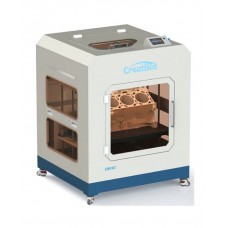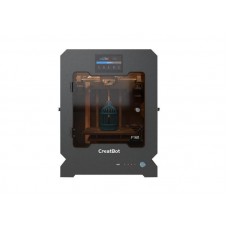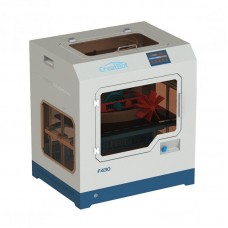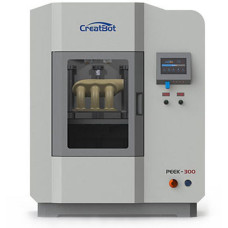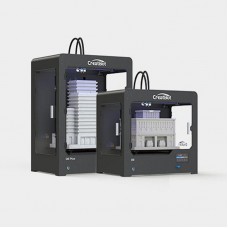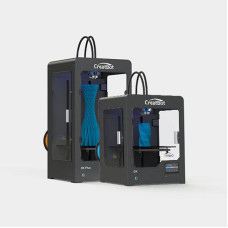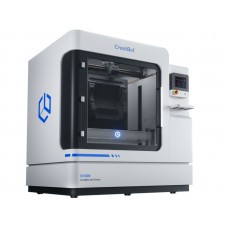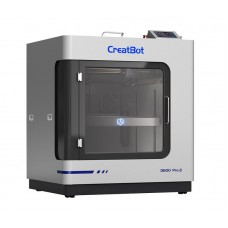Creatbot 3D Printers
Jump to Section:
- What is Creatbot?
- What do experts think about Creatbot printers?
- Why buy Creatbot?
- Which Creatbot 3D printer should I buy?
- What materials are supported by Creatbot 3D printers?
- What software can I use with Creatbot 3D printers?
- What parts and accessories are available with the Creatbot 3D Printers?
- What is the Creatbot's warranty policy?
- What special features do Creatbot 3D printers have?
What is Creatbot?
Henan Creatbot Technology Limited pioneers in desktop 3D printer manufacturing in China since its foundation in 2011. As a leader in large-scale and ultra-high temperature printing based on FDM (fused deposition modeling) print technology, Creatbot is renowned across central China and sells over 3,000 professional 3D printers annually in over 60 countries. Holding over 30 patents, its products are CE, FCC, and RoHS certified.
Redefining innovation since the first batch, Creatbot printers are trusted across diverse sectors such as education, aerospace, automotive, and healthcare. Esteemed partnerships include Tsinghua University, Harvard University, Foxconn, GE, ABB, TE Electric, Volkswagen, NASA, and the Canadian Department of Defense.
Creatbot provides comprehensive support through downloads, technical FAQs, and direct contact options like email and Skype.
Creatbot authorized Top 3D Shop as its value-added reseller in 2019. Top 3D Shop has sold over 200+ additive manufacturing systems manufactured by Creatbot and successfully completed 100% of the received client's support tickets. Customers who purchase Creatbot directly through Top 3D Shop receive local customer support from our technical center in California, USA.
What do experts think about Creatbot printers?
In our partnership with Creatbot, their innovation stands out. As a pioneer of desktop 3D printing in China, they develop and manufacture top-tier printers, designed for professional, large-scale, and high-temperature tasks. With these machines, clients achieve unprecedented precision and efficiency with impressive prints. What sets Creatbot apart is its reliability and performance. We recommend Creatbot to any business seeking advanced printing solutions. Their printers are game-changers, offering precision, scalability, and versatility. – David Mosley, 3D Solutions Specialist at Top 3D Shop
Why buy Creatbot?
Innovative Technology: Creatbot stands as a trailblazer in the desktop 3D printing sector in China. Their leadership and innovative spirit, demonstrated by such solutions as the D600 Pro industrial 3D printer, D1000, F430, and PEEK-300 models, ensure users access cutting-edge print technology for a broad range of applications. For example, the accurate linear guide rail structure ensures that Creatbot machines can print models in accuracy up to 4~5x higher than the other ordinary optical axis printers in mass market.
Diverse Product Range: Creatbot's array of 3D printers caters to various needs, from professional large-scale 3D printers like the D600 Pro series, designed for SMEs, to the F430 model, renowned for its desktop high-performance printing capabilities. Each model is developed with specific user needs in mind, ensuring a suitable option for every type of 3D printing project.
High Performance: Creatbot printers come equipped with advanced features that push the boundaries of the printing process. The D600 Pro 2 boasts a 600 x 600 x 600 mm build area, auto-rising dual extruders, and magnetic suction platforms for ease of use. The D1000, aimed at industrial-grade large prints, offers a 1 m³ build volume with enhanced precision and high-speed printing capabilities. The PEEK-300 leads in ultra-high temperature printing, with a nozzle that reaches up to 480 °C and a unique Direct Annealing System that lets you control the annealing process for superior material properties. Meanwhile, the F430 caters to those needing a professional desktop solution with dual extruders capable of reaching 420 °C.
Reliability and Professional Support: Creatbot printers are designed to operate 24/7. Apart from accurate filament feeding, they provide constant room temperature thanks to a fully enclosed chamber, quickly heated bed, and HEPA air filters to ensure sustainable and efficient operation as well as high quality prints with minimal supervision. Beyond hardware, Creatbot offers full-fledged support, including technical training and local services.
Global Trust: Creatbot's collaboration with prestigious institutions and partnerships with global companies across various industries signify the trust and reliability of their printing solutions. Their printers are utilized in diverse fields, including automotive, aerospace, medical, and education, showcasing the versatile application of their advanced technology.
Which Creatbot 3D printer should I buy?
Here is a list of Creatbot printers to choose from as well as what standard features to look out for:
Creatbot Large-scale Series
The D600 series responds to market demand with a 600 x 600 x 600 mm build volume, while the Creatbot D1000 model (ex Creatbot F1000) is a large-scale 3D printer that expands this to a cubic meter for impressively large models. Equipped with smart dual extruders reaching 420 °C, a hot chamber with a constant room temperature, and fast heating platform, these printers tackle such high-performance material as carbon fiber with ease. Due to the powerful extruder feeding system, they also support high-speed printing at 200 mm/s. High precision is guaranteed with layer resolutions down to 0.05 mm, and stability is ensured by robust servo motors and accurate linear rails. Features like the 70 °C hot chamber, auto-leveling, and outage restoration for the best printing quality and reliability.
Creatbot High-temperature Series
The CreatBot PEEK-300 stands as the epitome of high-performance printing, featuring a maximum nozzle temperature of 480 °C and a build volume of 300 x 300 x 400 mm. It's equipped with a Direct Annealing System (DAS) for superior material capabilities, targeting professional applications in medical and industrial fields. The PEEK-300 3D printer boasts vast filament compatibility including engineering plastics, high-temperature materials, and high-performance materials like PEEK (glass fiber) and carbon fiber for direct application. With dual extruders able to extrude filament steady, advanced thermal management, and a fully enclosed hot chamber with a heated bed temperature of 100 ℃, this printer is designed to tackle the most challenging 3D printing tasks without compromise.
Creatbot Professional Desktop Series
The CreatBot F series, featuring the F160 and F430, boasts high-temperature nozzles up to 420 °C, catering to a wide array of engineering-grade materials. The F160 3D printer, compact yet powerful, offers a build volume of 160 x 160 x 200 mm, making it perfect for educators and small-scale creators. Meanwhile, the F430, a professional powerhouse made of steel with aluminum casting for motion components, provides a larger build volume of 400 x 300 x 300 mm, nozzle diameter of 0.04 mm, and the reliability to run 24/7 and turn off the power automatically when printing is complete. Both printers feature a fully enclosed heated chamber, ensuring temperature stability, external interference and noise reduction, along with outage restoration and filament detection for an uninterrupted printing process.
Creatbot Classic D series
The CreatBot DX and DE series are synonymous with reliability and expansive build volumes. Supporting temperatures up to 260 °C, these printers handle multiple types of filament with grace, thanks to their all-metal hotends and customizable single to triple extruder configurations. High precision is their middle name, with layer resolutions fine-tuned to 0.05 mm and printing process speed up to 120 mm/s. The DX series offers a substantial build volume up to 300 x 250 x 520 mm, while the DE series goes even larger, accommodating large-scale objects up to 400 x 300 x 520 mm. Both series feature outage restoration, filament run-out detection, and a touch screen for effortless operation. With a whole-steel body, they're built like tanks, ensuring with their overall structure both stability and longevity in rigorous printing environments.
Case Studies
Frequently Asked Questions
What materials are supported by Creatbot 3D printers?
Creatbot's filament range is developed in collaboration with industry leaders like BASF. Their offerings include ABS, PLA, PLA-CF, PETG, TPU, PC, ASA, UltraPA, PEEK (glass fiber), PEEK-CF (carbon fiber), PA-CF, PVA, S-Multi, and other materials. These high-quality materials cater to a wide spectrum of applications, from aerospace to medical, highlighting Creatbot's commitment to providing versatile 3D printing solutions.
What software can I use with Creatbot 3D printers?
Creatbot printers are compatible with CreatWare. This free, multi-language, and user-friendly program supports all Creatbot printers, facilitating a smooth workflow from import to print. It allows for quick file uploading, selection of print parameters, powerful preview simulations, and G-code exporting directly to a USB flash drive for printing. CreatWare boasts a powerful slicing engine, various parameter modes, individual print setting adjustments, and features for auto-repair and simplification of models to achieve the best possible print quality. CreatWare supports the following file types: STL, OBJ, AMF; Operating systems: Windows, macOS.
What parts and accessories are available with the Creatbot 3D printers?
Creatbot offers an array of spare parts and accessories for their 3D printers. This ensures optimal performance, incredible results and greatly extends the usage period. Available items include mainboards, heating tubes, sensors, PCBs for extruders, cooling fans, chamber heaters with fans, motor wires, limit switch sensors with servos, cooling fins, heat blocks, thermistors, high-temperature hotends, air filters, filament run-out sensors, heating tubes, a brand BL touch probe, and more.
What is the Creatbot's warranty policy?
Creatbot offers a 12-month warranty from the delivery date to the first end-user, covering products against defects in materials and workmanship. Spare parts damaged within the warranty period are replaced free of charge, excluding nozzles and hot-ends, which have a 6-month warranty. Online support is provided for life. Read the full terms here: https://www.creatbot.com/en/warranty.html.
What special features do Creatbot 3D printers have?
Each Creatbot machine responds to market demand by incorporating the following features: Outage Restoration: Creatbot printers save data when power is off to avoid invalid printing and resume the process from where it left off once power is restored. Lower the platform and withdraw filament when power off suddenly. Filament Detection: pause printing when filament ends to save data, prevent print failures and loss of your project; the machine is engineered to save print data and pause if filament runs out. Automatic Shut Down: turn off the power when printing is complete to save energy and extend the usage period. Camera Control Technology: with the real-time control options customers can remotely monitor and control printing process with an APP.









